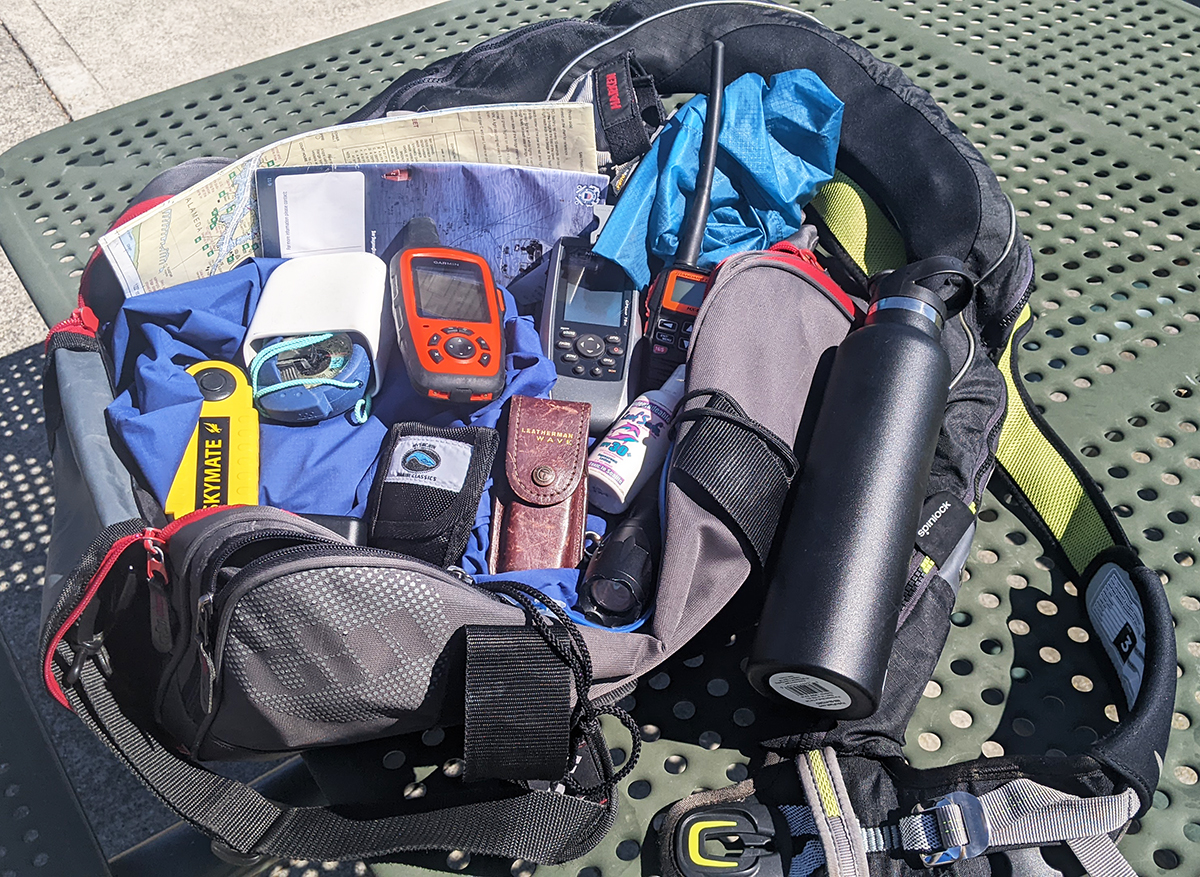
If you’re new to sailing, you may have noticed some sailors carrying hefty duffles or dry bags on their way down to the docks. Ever wonder what experienced sailors and skippers keep in those gear bags? Let's have a look at some of the most common items. You'll also find out what makes sense for you to pack for a sail depending on your level of experience and commitment.
Sailing Gear Essentials - "Must-Haves"
If you sail infrequently or are planning for your first sail, you can consider these items most essential.
- Clothing: Layers & Extras – Rightfully, one of the biggest concerns for every SF Bay sailor is to stay warm, dry, and comfortable while out on the water. Follow this shortcut to learn more about what footwear and clothing to wear and pack for safety and comfort in any of the conditions you may encounter on the Bay: What to Wear Sailing on San Francisco Bay - Three Rules to Keep You Warm and Dry. (We also empasize that packing extras is a boon!)
- Indestructible Water Bottle – A stainless steel bottle with flip-top or pop-top is ideal. When it's bouncy out there, some sailors find screw-tops to be a hassle. It’s also a great idea to attach a sturdy string and carabiner to your bottle and connect it to a secure point on the boat. When cold weather is expected, many sailors like to bring an insulated bottle or sealed travel mag (i.e. Thermos) to enjoy a hot beverage.
- Meals / Snacks – Unless you expect to dine in calm conditions, opt for easily handled finger-foods. Hunger will increase your odds of seasickness, fatigue, and brain fog. Snack lightly but frequently. Even if you never get seasick, candied ginger could come in handy for a queasy crewmate. A can of ginger ale to wash down some saltine crackers can also help soothe a tummy in turmoil. For the best protection from messy leaks and crushing, we recommend to keep your eats stored in stainless steel containers. Plastic containers also work, but whenever you can avoid bringing plastic containers aboard (which can sometimes end up overboard), all the better.
- Personal Care Items (i.e. Sunscreen, Lip Balm, Moisturizer, Eye Drops, Facial Tissues) – The wind, sun, and salt water can be tough on exposed skin, lips, and eyes. Keep these items in a smaller bag or pocket inside your gear bag. Hand sanitizer is also a good idea these days.
- Hand Towel or Cloth Napkin – It’s so nice to have a clean napkin or towel to dry your face and hands on those sprinkly or splashy days or to freshen up after a nosh. A couple of cloth napkins and/or a compact Turkish hand towel are a perfect choice for your gear bag.
- Sack for Soiled or Wet Items – If your napkin, hand towel, or something you've worn gets wet, you'll want a way to keep it separate from the rest of your gear. Just don't forget to remove it from your gear bag when you get home!
- Your Preferred Personal Floatation Device (PFD, aka life jacket or life vest) – There are many types of PFDs available on the market, from the slim, modern inflatables to the fluffier, bulkier classics. Our advice is to select a PFD that's both US Coast Guard approved and comfortable to wear. It's also helpful if your PFD has a tether attachment point. For obvious reasons, an inflatable is easier to pack in a gear bag. Planning to sail on a Modern Sailing yacht but don't have a PFD of your own? No worries - we've got you covered!
Sailing Gear "Smart-to-Haves"
Are you committed to sailing more regularly, cruising the coast or offshore, or enjoying the occasional overnight charter? Awesome! It's a great time to invest in some additional equipment for your safety, comfort, and convenience.
- Sailing Safety Tether – Most of the time when you're sailing inside the Bay, you won't need a tether. If you encounter extra chop, you'll be more secure "clipped in" by attaching your tether to a secure point inside the cockpit. Outside the Bay, clipping in is mandatory for safety. If your PFD does not have an appropriate tether attachment point, you'll also need a safety harness. Tethers are also great safety equipment for kids while sailing. If you're going on a Farallones Day Trip, Half Moon Bay Trip, ASA 106, Advanced Coastal Cruising, or ASA 105/106 California Coastal Combo course, Modern Sailing can supply you with a loaner tether.
- Sailing Knife with Marlin Spike – Knots happen! A sailing knife will marlin spike will come in handy to loosen those stubborn knots in a jiffy.
- Waterproof Head Lamp with Red Light – Working on deck or the dock at twilight or after dark, you'll be glad to have a waterproof head lamp with red light option. When you need the extra lighting intermittently, the red light option will help preserve your night vision.
- Waterproof Smartphone Pouch with Lanyard – If you use a navigation app or take a lot of photos with your smartphone, keep your phone in a waterproof pouch attached to a lanyard around your neck. This will not only keep your phone dry, it will keep it from falling overboard. Tuck it inside your shirt, jacket, or PFD to keep it out of the way.
- Compact Travel Blanket / Space Blanket – If you or a crewmate gets soaked or shows up underdressed for the conditions, a space blanket can save the day. Space blankets are great for a gear bag because of their diminutive size, but are generally considered disposable after a single use. A compact travel blanket will take up a bit more space in your bag, but can be washed and used again.
- Hand Warmers – Tuck hand warmer packets into your gloves, shirt, or hat for a touch of cozy warmth on those chily day or night sails. Handing out extras to your crewmates is a great way to make new friends!
- Binoculars – Essential for navigation and great to have for ogling amazing vessels and wildlife. Select a lightweight, compact set for your gear bag.
- Hand Bearing Compass – Hand bearing compasses are an essential tool for coastal chart navigation. (Learn more about compass navigation with our ASA 105, Coastal Cruising course.)
- Seasickness Medication – This is only necessary for sailors who know they may be prone to seasickness in rough conditions. Worried you'll get seasick? Learn 10 Tips to Prevent and Remedy Seasickness.
Sailing Gear "Nice-to-Haves"
- Croakies – Keep your sunglasses attached to you with a set of croakies.
- Hat Leash – The Bay's strong summer winds have a way of snatching hats from heads. A hat leash will prevent the loss of your favorite headgear. Hat leashes and croakies are fairly inexpensive, so why not carry an extra set to share?
- Waterproof Handheld Floating VHF Radio with GPS – A great item for skippers! Clip a handheld VHF radio to your PFD so that the ability to communicate and know your exact GPS position is always within reach.
- Knee Pads – Not every sailor will want or need knee pads, but many racers greatly appreciate them for the prevention of boat bites on sensitive knees.
- Bottle Opener – Bring along a tool that can open a variety of beverage bottles and cans to aide your dockside and anchorage meals and celebrations. Many sailors carry a multi-tool that includes a knife, marlin spike, bottle and can openers, and more!
What you WON’T Need to Bring Aboard a Modern Sailing Yacht
You're always welcome to bring your own, but know that all Modern Sailing charter yachts come equipped with:
- Personal Flotation Devices (PFDs) – All MSC yachts are equipped with 6 - 12 adult universal classic PFDs (the number depends on the size of the boat). NOTE: The US Coast Guard requires all minors aged 12 or younger to wear a PFD at all times when aboard a boat. The Modern Sailing office keeps loaner child-sized life vests in our office. Of course, we recommend that sailors of all ages always wear a PFD when out on the water.
- SF Bay Chart and Basic Charting Tools
- USCG Navigation Rules Book
- Handheld Flashlight
- First Aid Kit
- Air Horn
- Type IV Throwable PFDs
- Emergency Flares
Did you find this article helpful? Please share on social media! You'll find buttons to share on the bottom of this page. You might also enjoy some of our other Member Resources articles on the subject of safety:
- The Crew Briefing: An Essential Pre-sail Safety Practice
- Common Sailing Injuries and How to Prevent Them
- It's Easy to Prevent the Costly Consequeces of "Prop Wrap"
- How to Find Your Way Back to Harbor in the Dark or Fog
- Handling Emergencies Part I: Predeparture Safety Checks
Article by Mary Elkins on June 9, 2022


